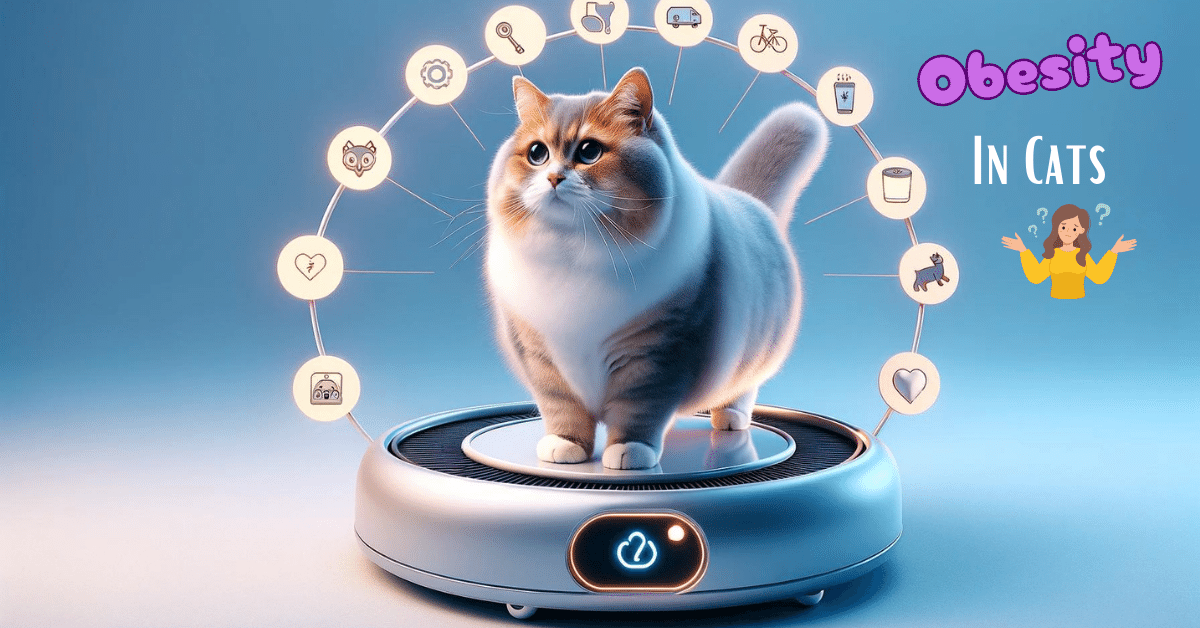This post contains affiliate links and I will be compensated if you make a purchase after clicking on my links.
Opening Paws: Confronting Cat Obesity
Cats have conquered more than just the internet and our hearts; they’ve also, unfortunately, started to win a less adorable battle – that of the bulge. In homes around the globe, the whiskered rulers of our world are facing an epidemic that’s silently impacting their health and vitality: obesity in cats.
Obesity in cats is defined as weighing 20% or more above their ideal body weight. This condition isn’t just about carrying a few extra pounds; it’s a critical health issue affecting a significant portion of felines in developed countries.
As devoted companions to these purring internet stars, it’s crucial we turn our attention to this growing concern, understanding its implications, and taking action to reverse the trend.
The Heavy Toll: Navigating Obesity in Cats
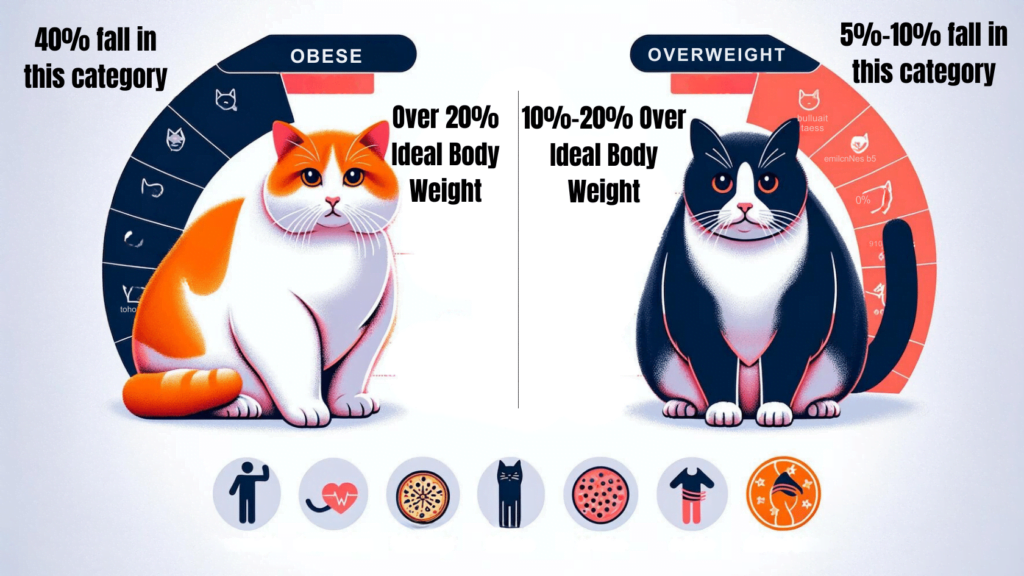
Overweight Cats
- Cats that are 10-20% over their ideal body weight.
- Represent a significant yet somewhat less concerning portion of the pet population, with an estimated 5-10% falling into this category.
- Overweight status may lead to some health issues but is generally seen as more manageable.
Obese Cats
- Cats that are over 20% beyond their healthy body weight.
- A more alarming condition due to its severity and the associated health risks, with an estimated 40% of cats considered obese.
- Obesity in cats rings alarm bells due to its direct linkage to severe health complications.
The Not-So-Purrfect Impact of Obesity on Cats
The consequences of obesity in cats stretch far beyond a few extra pounds, impacting both their quality of life and longevity:
- Short-term Effects: Decreased mobility, difficulty grooming, and a general drop in energy and playfulness.
- Long-term Risks: Serious health issues like cardiovascular disease, diabetes, arthritis, and even a weakened immune system, significantly shortening their lifespan and potentially leading to a life filled with discomfort and medical challenges.
Note: Cats with a body condition score of 5 have a life expectancy of 12.56 years, which is significantly lower than the typical average life expectancy of between 13 to 17 years
Identifying and Diagnosing Obesity in Cats
Identifying obesity in our feline friends can often start at home with observations from their human companions.
Here’s a quick guide to spotting the signs:
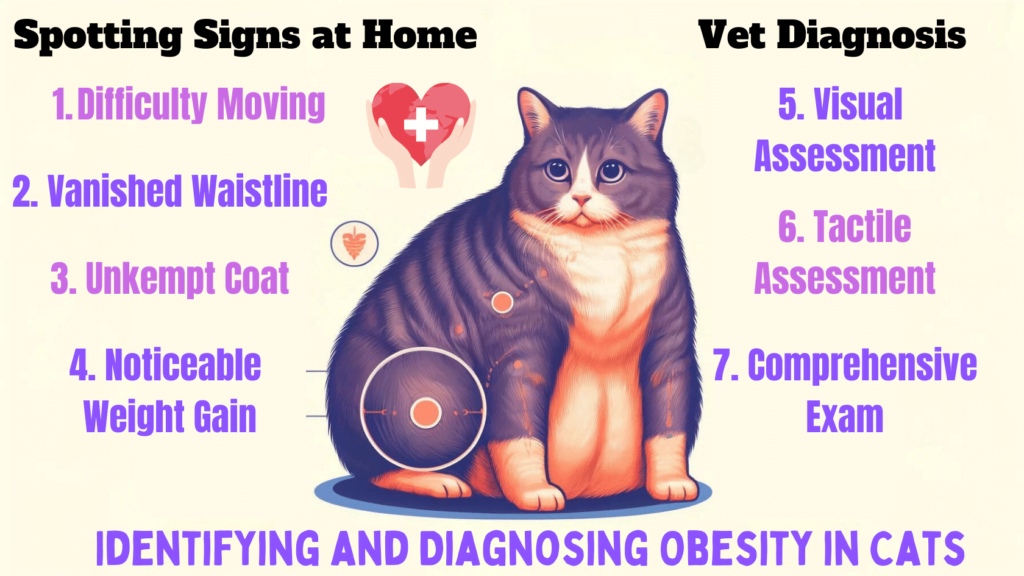
- Difficulty Moving: Less enthusiasm for play or struggle with jumping and climbing.
- Vanished Waistline: The sleek feline silhouette is obscured by extra weight.
- Unkempt Coat: Grooming becomes a chore, leading to a less tidy appearance.
- Noticeable Weight Gain: An obvious increase in size and heft.
While these signs can be visible to owners, a veterinarian diagnosis should follow these initial observations:
- Tactile Assessments: Gently feeling for fat deposits, particularly around the rib cage and under the belly, to gauge the amount of excess fat.
- Comprehensive Exam: Vets perform bloodwork to pinpoint key indicators such as elevated blood glucose levels suggesting diabetes, high cholesterol and triglycerides hinting at cardiovascular issues, and abnormalities in liver, kidney, and thyroid function tests.
- Visual Assessment: Observing the cat’s body for the visibility of ribs and hip bones, which helps in understanding the body’s fat composition. A visible waistline, or lack thereof, provides clues about your cat’s body condition.
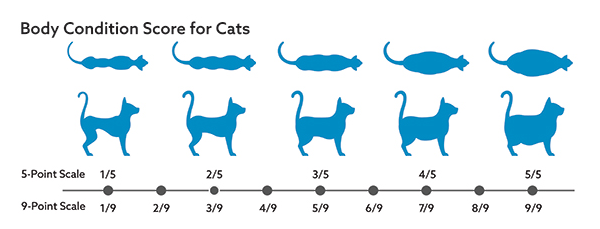
Body Score Condition Chart
Pro Tip: Just like human BMI, Feline BMI helps determine if your cat is underweight, normal weight, overweight, or obese. It’s a simple and effective way to assess your cat’s health. Use our Cat BMI Calculator to easily monitor your furry friend’s well-being.
How Did We Get Here? The Causes of Feline Obesity
Navigating the jungle of feline obesity reveals a complex web of causes. Let’s pounce on some of the main culprits:
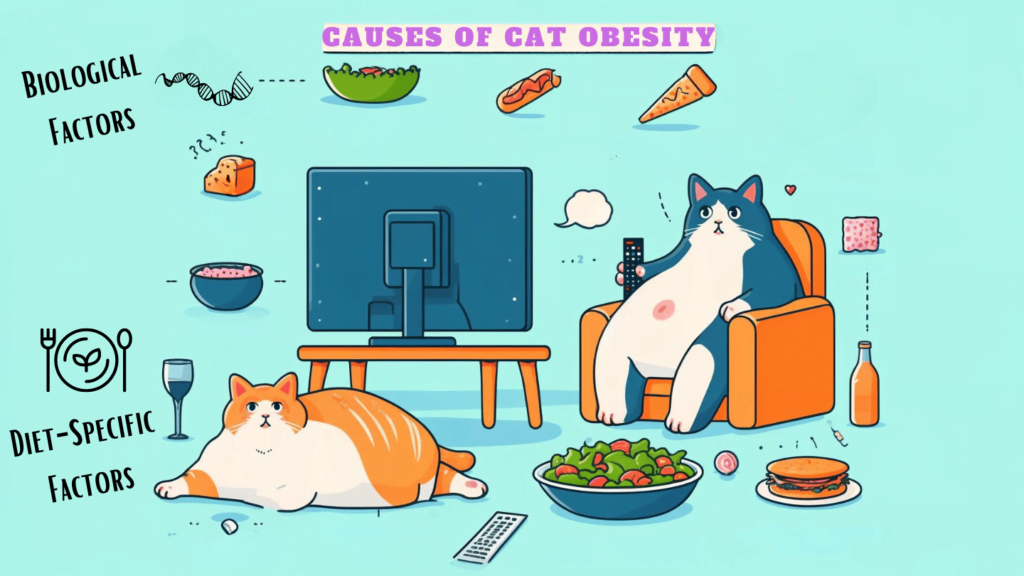
Biological Factors
- Age: Just like humans, cats tend to put on weight as they age and their metabolism slows.
- Sedentary Lifestyle: This lack of movement contrasts sharply with a cat’s natural instincts for hunting and exploration, leading to weight gain and associated health risks.
- Neutering Status: Neutered cats have a higher risk of gaining weight due to hormonal changes affecting appetite and metabolism.
- Underlying Health Issues: Sometimes, obesity can be a symptom of underlying health issues like hypothyroidism.
Diet-Specific Factors
- Inaccurate Food Measurement: Many cat owners, with the best intentions at heart, eyeball their pet’s food portions, unknowingly setting the stage for overfeeding.
- Lack of Dietary Variation: Feeding the same food continuously can not only lead to boredom but also nutritional imbalances that contribute to weight gain.
- High-Carbohydrate Diets: Cats are carnivores by nature, requiring a diet high in proteins. Diets with excessive carbohydrates can lead to unnecessary weight gain.
- Free-Feeding Practices: Leaving food available all day encourages cats to eat out of boredom rather than hunger, leading to weight gain.
- Rapid Consumption: Cats that eat too quickly may consume more calories than they need.
- Treat Dependency: Over-reliance on treats for bonding or behavioral training can significantly increase caloric intake.
Treatment and Management of Obesity in Cats
Addressing feline obesity requires a comprehensive approach, focusing on both diet and lifestyle changes.
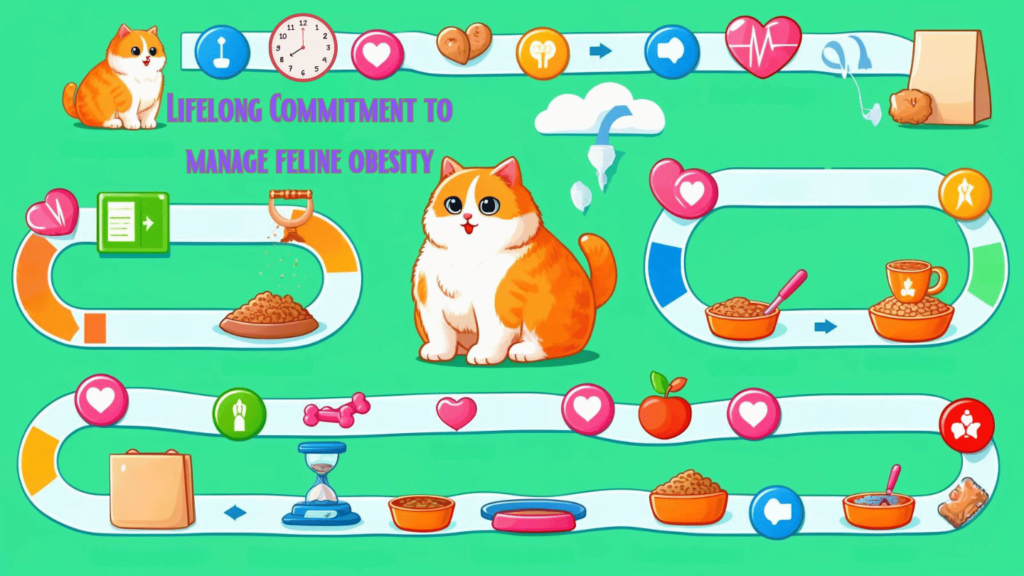
Targeted Calorie Intake and Feeding Strategies
Transitioning to a new diet should be as smooth as a cat’s sleek jump from the countertop to the sofa. Gradually introduce the new chow over 7-10 days to keep those tummy troubles at bay.
- Calorie-Restricted Foods: These diets are meticulously formulated to ensure that cats receive all essential nutrients while reducing their calorie intake. Such diets often include high-quality protein sources to maintain muscle mass during weight loss, fiber to promote satiety, and a balanced blend of vitamins and minerals to support overall health.
- Switching from Dry to Canned Foods: Wet foods generally have a higher moisture content, which can help cats feel fuller sooner and stay hydrated.
- Prescription Diets: Some cats may require diets formulated to address specific health issues alongside obesity, such as diabetes or kidney disease. These diets are tailored to manage the cat’s condition while helping them achieve a healthier weight, and should only be used under veterinary guidance to ensure they’re appropriate for the cat’s individual health needs.
- Portion Control: Precise portion control is key in preventing overfeeding. Using kitchen scales or specific measuring cups for pet food can help administer exact amounts as recommended by your vet.
- Meal Frequencies: Establishing a consistent feeding schedule, with two to three measured meals a day, can regulate a cat’s eating patterns and metabolism. This structure helps in reducing incessant begging behaviors and ensures that cats don’t consume more calories than they need.
- Ensuring Adequate Hydration: Proper hydration is essential, especially when managing weight. Water aids in digestion and helps metabolize fat. Encourage your cat to drink more water by placing fresh bowls around the house or using water fountains, which can also stimulate their interest in drinking.
Encouraging Activity and Environmental Changes
Active engagement and a stimulating environment are crucial for a cat’s physical and mental health, especially in the battle against obesity.
Here’s how to incorporate more activity into their daily routine.
- Puzzle Feeders: Beyond merely slowing down fast eaters, puzzle feeders engage a cat’s brain, making them think and work to access their food. This not only aids in weight management by controlling eating pace but also serves as mental exercise.
- Leash Walks: Taking your cat for a walk on a leash provides controlled physical activity and ensures their safety. It also offers multiple benefits, including sensory stimulation from the environment, which is vital for their mental wellbeing.
- Interactive Toys: Toys that mimic prey movements, like feather wands or motorized mice, tap into a cat’s natural hunting instincts, encouraging them to stalk, pounce, and leap.
- Scheduled Playtime: Dedicate time each day for active play with your cat. Consistent engagement not only helps in managing weight but strengthens the bond between you and your pet.
Moderation of Treats
- Treat Calories Reduction: Opt for low-fat treat options and ensure that treats do not exceed 10% of your cat’s daily caloric intake. This percentage should align with your vet’s recommendation or the estimate provided by our cat calorie calculator.
Important: The management of feline obesity involves regular check-ups and monthly weigh-ins, essential for tracking progress and adjusting diet plans to ensure safe and effective weight loss. It’s important to view this as a lifelong commitment to our cats, requiring patience, dedication, and ongoing veterinary support to maintain their health and well being.
Prevention and Recovery from Cat Obesity
The best approach to combat obesity in cats involves proactive prevention and consistent weight maintenance strategies. Early intervention is key; recognizing and addressing early weight gain can thwart full-blown obesity.
Continual monitoring of a cat’s weight and body condition is crucial, as is vigilance in managing portion control and ensuring a balanced diet to prevent weight regain and maintain a healthy weight.
As your cat ages, nails its weight goals, or if new health quests pop up, revisiting the plan is key. Consistent follow-ups with your vet are the secret sauce to keeping your feline friend on the path to success. It’s not a one-and-done deal; it’s an ongoing journey to ensure your cat stays healthy, happy, and agile.
Combatting Feline Obesity with Modern Solutions
In today’s digital era, we have a plethora of innovative tools at our disposal to help our feline friends stay trim and engaged:
- Cat Exercise Wheels: A fantastic outlet for their energy, these wheels cater to their instinct to roam and sprint.
- Automatic Feeders: Smart feeders and other automatic feeders can schedule portions accurately based on the vet’s advice or the daily calorie intake needed. This ensures your cat gets the right amount of food at the right times, helping to prevent overfeeding.
- Exercise Gadgets: From smart laser toys that dart around, mimicking prey, to interactive feeders that make mealtime a brain game, there’s no shortage of options to get your cat moving.
- Health Monitoring Tools and Nutritional Tech: Wearables and apps that track activity levels, dietary intake, and even offer feeding suggestions can play a pivotal role in managing feline obesity.
Final Thoughts on Feline Wellbeing
Let’s not just dream of a world where every cat lives its nine lives to the fullest; let’s make it a reality. By embracing a comprehensive approach that includes diet modification, regular exercise, ongoing monitoring, and seeking professional guidance, we can ensure our furry companions enjoy a healthier, happier existence.
Meet Sean, a fintech whiz with a penchant for pet purrs and blockchain buzz. After a decade of fintech feats, Sean’s tech talents leaped from ledger lines to litter lines, driven by a passion for pets and a vision for a more connected pet care community. With three critter companions as co-pilots, Sean launched this blog to share a treasury of pet-friendly tech tips and tales.

